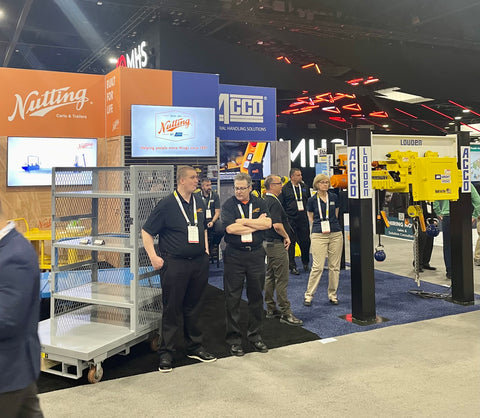
What Was MODEX’s Story?
The manufacturing and supply chain community came together for a record-setting MODEX. But what did the show tell us about the state of our industry? Richard Howes begins by sharing three observations.
The major talking point of MODEX was the findings of organizer MHI’s latest annual report titled, 'Evolution to Revolution: Building the Supply Chains of Tomorrow'. I’ll come to sharing my thoughts on that, but here are three things industry isn’t talking about:
- Carpetgate
- New demographic
- MODEX masses
Carpetgate
One of the lifting industry’s magazines asked me to record some thoughts for a video they were putting together about MODEX, which took place March 28-31 at Atlanta’s Georgia World Congress Center. I couldn’t resist mentioning in closing that I didn’t like MHI’s choice of carpet. Sorry!
If you look at a trade show of this scale the evening before the doors open, you’d never believe the venue staff, exhibitors, and organizers would ever finish in time. It’s always like that—forklifts are hurtling around skids that are lying on top of other skids. Rubbish is everywhere. Somehow by the time morning dawns, the setting is serene. Booths are pristine and everything is as though it was always there.
I didn’t want to be a party pooper, but I just thought having gone to all the trouble and expense to decorate the Georgia World Congress Center with magnificent signage and generally make the place feel like home, a better carpet could’ve been chosen versus the thin, gray, frayed piece of matting that did at least soften footfall.
Since, I’ve had countless people say things like, “Don’t mention the carpet,” in jest, so I guess I must own the comment now.

MODEX exhibitors wait for another influx of attendees.
New demographic
MHI reported that 20% more visitors (37,047) walked the aisles than the last pre-pandemic show in 2018 and calculated a direct economic impact to the Atlanta area of $45 million.
I agree with John Paxton, CEO of MHI, that the show was, “…a huge success and a dramatic return to in-person events for the supply chain industry”. But what really stood out for me was how diverse and youthful the demographic was. I first walked an MHI show in 2007, and most people were, frankly, male, aging, and white. That has changed appreciably over the years, with the biggest acceleration towards a younger and wider audience seemingly taking place over the pandemic years.

The MODEX entrance hall at Atlanta’s Georgia World Congress Center.
MODEX masses
Trade shows used to be celebratory occasions where people would come together every year or two, chink glasses, and exchange stories. That was the case to some extent until recent years, but tighter budgets meant it was much less the reality. People would have to work harder for sign-off to spend time in a city away from their desk or workstation and where a bunch of people from one company were once sent to sample exhibitors, CFOs started to insist that one person might be able to do the job.
I disagree with that mentality given how quickly time goes at a show and how important it is to take networking and product-viewing opportunities, even if I do understand it given the price of flights, hotels, subsistence, entertaining, etc. these days. But it was good to see MODEX buck the trend, with huddles of people hitting the (gray carpeted) floor wearing the same company t-shirt or badge.

FAD Equipment Store vendor OZ Lifting was among busy MODEX exhibitors.
As Paxton observed, people were, “…excited to be there and energized by the opportunity to connect and get back to the business of discovering the latest supply chain technology and innovation in-person”.
Industry report
During the March 30 keynote, Paxton and Deloitte’s Thomas Boykin released the findings of the 2022 report, detailing the revolutionary adoption of supply chain technology that is predicted to make operations more responsive and agile amid ongoing disruptions.
As the report accepted, thanks to a perfect storm of global supply-related issues, supply chain disruptions are now a topic of daily conversation. Meanwhile, news stories are throwing fuel on the fire by repeatedly calling attention to widespread supply shortages in everything from computer chips to groceries.
Where last year's report focused on the supply chain vulnerabilities that were exposed by the global pandemic and the resilience that innovation adoption can provide, this year business and supply chain leaders are challenged to benefit from those insights by embracing ground-breaking innovations that can revolutionize how supply chains operate—enabling future supply chains to thrive in the face of inevitable disruptions.

Mark Bridger (right) and I, having set-up our MODEX show booth on Sunday March 27.
Paxton reported, “Supply chain leaders have never been in a better position to drive impactful and lasting change for the industry. With the white-hot media spotlight chronicling the after-effects of the pandemic, the importance of supply chain is finally coming into focus in boardrooms across the world”.
- Did you know that, according to a Wall Street Journal report, there were 2.2 million mentions of the term “supply chain” on Twitter in the fourth quarter of 2021, five times more than in any quarter of 2019?
“Data is the first step in the evolution of insight,” said Boykin.
“The supply chain has gone from an era of invisibility to being watched and scrutinized by the average consumer in the marketplace, which changes the way supply chain has to work their processes,” suggested Terry L. Esper, Fisher College of Business at The Ohio State University.
MHI and Deloitte surveyed more than 1,000 supply chain and manufacturing leaders to learn how they are responding to the global pandemic—and how they are transforming their supply chains to become more resilient through adoption of certain digital technologies.
Expected investment levels in supply chain innovation over the next two years are rising sharply. Of the 64% of respondents increasing investments, 66% say they will spend more than $1 million over the next two years. We’re certainly looking forward to getting our slice of that pie here at FAD Equipment Store.

MODEX reportedly had a direct economic impact to the Atlanta area of $45 million.
Workforce and technology
Of course, while supply chain disruptions and shortages are today’s most pressing matter, hiring and retaining qualified workers is still a huge issue. Robotics and automation continue to top the list of innovations that survey respondents believe have either the potential to disrupt the industry (17%) or to create competitive advantage (39%). However, a handful of other technologies are very close behind, including:
- Predictive and prescriptive analytics
- Sensors and automatic identification
- Autonomous vehicles and drones
- AI technologies
As Deloitte’s Boykin said, in an increasingly digital world, data is a priceless asset—particularly when it comes to avoiding and addressing supply chain disruptions. However, a supply chain organization’s ability to harness the power of data is only as good as its visibility into the data being generated and used across its ecosystem. Achieving the desired level of visibility starts with identifying all stakeholders in the ecosystem and what information they are generating—and what information they need in order to operate effectively and address internal and external vulnerabilities.
Conclusion
Companies today are cautiously optimistic about 2022 and are developing plans to support renewed business growth. Continuing to deliver high quality products and customer experiences while keeping prices competitive will require innovative solutions. Younger generations of workers and consumers are very concerned about climate change and other environmental, social, and governance (ESG) issues. They want to know if a company is behaving responsibly and doing its part to protect the environment. CEOs are taking notice.
Whether you walked the carpet of not, it’s clear that the dominant trend at MODEX surrounded digital supply chain solutions including automation, robotics, artificial intelligence, autonomous vehicles, augmented reality, the Internet of Things, and data analytics.
What did you think of the show? And the carpet?

Leave a comment